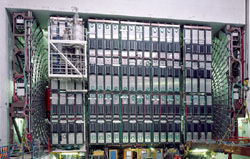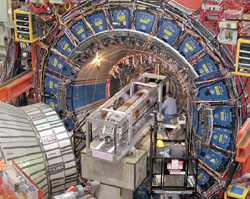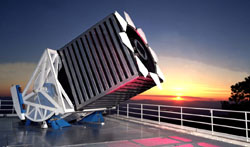 |
|
Around the Lab: Fermilab Prospects in 2004 Accelerator Division The progress made during the shutdown--major improvements in all the machines including the Recycler, the driving force behind the shutdown--has me eagerly anticipating 2004. In the Tevatron, major jobs included alignment and cold lifts of the magnets, and reducing impedance by putting liners in the injection Lambertson magnets. Results have already shown in the startup. Improvements are also expected from damper installation in the Main Injector. The Booster had some modifications to a dogleg orbit bump to reduce beam losses from the beam encountering imperfect magnetic fields as it crosses into and out of the dogleg magnets. In the Antiproton Source, the installation of motorized quadrupole stands, alignment improvements, and cooling improvements were major work list items. These changes will increase the antiproton accumulation rate. Perhaps the best news of all is from the Recycler. Resolving Recycler vacuum issues was the key for the shutdown, and the effort was very successful. The Recycler will make a major contribution to the delivered luminosity in the coming years. Electron cooling will be installed in the Recycler in approximately a year. After that, the Recycler with electron cooling will be integrated into operations. The Accelerator Division also made good progress on installing the NUMI beam line during the shutdown. More work remains for the 2004 shutdown, and we expect to deliver the first beam to NUMI in early 2005. --Roger Dixon DZero
We are pushing hard to exploit all the data that we now have and additional data from 2004. Our new top-mass measurement technique will give much improved precision to Run II data. We are hot on the trail of single top production, which has never been seen so far. We have a strong B-physics group, eager to exploit the detector's new capabilities to study Bs mixing and other heavy flavor physics. And we are keen to make precise measurements of W and Z bosons, high momentum jets and photons, and to exploit our Forward Proton Detector to understand diffractive phenomena. We are also searching hard for evidence of physics beyond the standard model. Our increased dataset, higher collider energy and improved detector capabilities already have us exploring unknown territory. We are setting the tightest limits on new particle production--but what we really want is not to set limits, but to see something unexpected. We don't know whether this will happen in 2004, but there's no reason why not. --John Womersley, Jerry Blazey CDF
CDF has submitted the X (3872) particle to Physics Review Letters. Next up: studying its properties, especially those that complement Belle. The X is huge in CDF compared to Belle, offering a good chance of finding new particles.
CDF will contribute to the measurement of the angle gamma by measuring the We plan to measure the top mass in several different ways, and to meet the challenge of measuring the W mass. Improved top and W masses improve constraints on the standard model Higgs. We will push beyond Run I limits in completing our initial analysis for the Higgs from supersymmetry. We will complete the search for the doubly charged Higgs H++ on 220 pb-1. The Standard Model Higgs is beyond our reach for some time, but there may be surprises--theorists think there may be a relation between the Higgs field and dark energy. CDF moves toward the world wide CDFGrid, with a workshop planned in January, and with computing available for data analysis in Taiwan, Japan, Korea, Canada, UK, Germany, and the U.S. outside Fermilab. --Nigel Lockyer, Luciano Ristori Neutrinos
MiniBooNE: MiniBooNE should surpass the 5M neutrino events milestone, which brings us halfway to our goal. Also, we should have non-oscillation physics results available on charge current quasi-elastic scattering, neutral current pizero production, and neutral current elastic scattering. We're expecting our oscillation physics results to be ready in the summer of 2005. --Bill Louis Astrophysics Pierre Auger Observatory: The Pierre Auger Observatory is beginning a large expansion. We have deployed over 200 surface detector stations and hope to have nearly half of the array (800) by the end of 2004. By June of 2004 we will have half the observatory's 24 fluorescence telescopes operational. By the end of 2004 we expect to have a data set that will allow a meaningful comparison of results with those of the AGASA array in Japan. --Paul Mantsch
CDMS: The Cryogenic Dark Matter search (CDMS II) experiment is currently taking data in the Soudan underground mine in northern Minnesota. By January, 2004, our first tower of 6 detectors will have accumulated sufficient exposure to improve our sensitivity to weakly-interacting massive particles (WIMPs) by an order of magnitude compared with CDMS I. After some small improvements, we will then turn on our second tower of detectors and run until the summer of 2004, with the expectation of further improvements in sensitivity and the hope to see a signal. Meanwhile, more detectors are being made and tested for backgrounds. During the summer, we will warm the apparatus to room temperature and install as many low-background detectors as we can. After a commissioning period, the full experiment will begin running and continue through 2005. --Dan Bauer Theory The work on this floor tends to be less programmatic than in other departments. However we do have hopes. From the experiments we all hope for something completely unexpected and inexplicable, which would really challenge us. Failing that we would settle for a heavy Z boson, a signal for supersymmetry or strange behavior of the top quark. Members of the department will be working hard to interpret the data from experiment. The more programmatic efforts include (but are not limited to) lattice QCD, (working primarily on semileptonic B and D decays and Bs mixing) QCD Monte Carlo, (where people are working on NLO Monte Carlo's for general processes). --Keith Ellis
On the Web:
Fermilab |
| last modified 12/31/2003 email Fermilab |
FRLsDFx9eyfrPXgV



